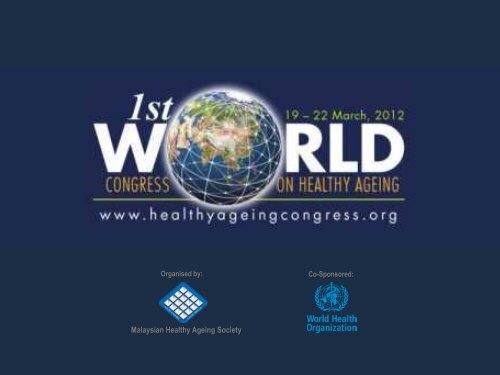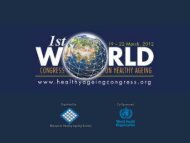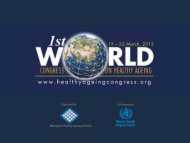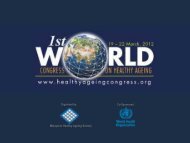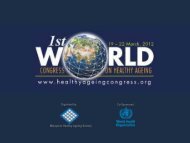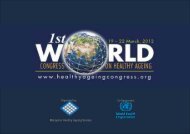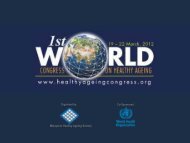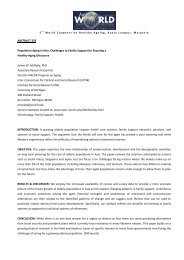The Cultural Perspectives of Physical Activity and Its Barriers in ...
The Cultural Perspectives of Physical Activity and Its Barriers in ...
The Cultural Perspectives of Physical Activity and Its Barriers in ...
Create successful ePaper yourself
Turn your PDF publications into a flip-book with our unique Google optimized e-Paper software.
Organised by:<br />
Co-Sponsored:<br />
Malaysian Healthy Age<strong>in</strong>g Society
*<br />
Sazl<strong>in</strong>a Shariff Ghazali 1,3 , Colette Brown<strong>in</strong>g 2 ,<br />
Shajahan Yas<strong>in</strong> 3<br />
1<br />
Department <strong>of</strong> Family Medic<strong>in</strong>e, Faculty <strong>of</strong> Medic<strong>in</strong>e <strong>and</strong> Health Sciences, Universiti Putra Malaysia,<br />
Malaysia<br />
2<br />
Primary Care Research Unit, School <strong>of</strong> Primary Health Care, Monash University, Australia<br />
3<br />
Jeffrey Cheah School <strong>of</strong> Medic<strong>in</strong>e <strong>and</strong> Health Sciences, Monash University Sunway Campus, Malaysia
* Regular physical activity <strong>in</strong> older persons with type 2 diabetes has<br />
many health benefits<br />
(Sigal et al 2007, Church et al 2005, Gregg et al 2003)<br />
* However, participation rate rema<strong>in</strong>s poor<br />
(Shazwani et al, 2010)<br />
* <strong>Barriers</strong> to physical activity is a major contribution to nonparticipation<br />
* <strong>Barriers</strong>: Personal, family environment, physical environment, cultural<br />
barriers<br />
* Motivators: health related (perceived good health, social support: family,<br />
friends <strong>and</strong> healthcare providers)<br />
(Kolt et al 2006, Mier et al 2007, Shazwani et al 2010, Bird et al 2009)<br />
* Def<strong>in</strong><strong>in</strong>g physical activity <strong>and</strong> its barriers has been extensively<br />
reported, very few studies explored cultural contributions to<br />
perceptions <strong>of</strong> physical activity<br />
*
To explore the cultural def<strong>in</strong>ition <strong>of</strong><br />
physical activity <strong>and</strong> its barriers <strong>in</strong><br />
older Malays with type 2 diabetes<br />
*
*A qualitative study was<br />
conducted <strong>in</strong> an urban primary<br />
care cl<strong>in</strong>ic <strong>in</strong> Selangor, Malaysia<br />
*Part <strong>of</strong> a RCT to promote<br />
physical activity <strong>in</strong> sedentary<br />
older adults with type 2<br />
diabetes<br />
*Four focus groups were<br />
conducted<br />
*A total <strong>of</strong> 25 Malay participants<br />
aged ≥60 years with type 2<br />
diabetes, who were either<br />
sedentary or did regular<br />
exercise were purposively<br />
recruited<br />
*
*<strong>The</strong>y were asked to explore the mean<strong>in</strong>g <strong>of</strong><br />
physical activity <strong>and</strong> barriers to physical<br />
activity us<strong>in</strong>g a guid<strong>in</strong>g questions<br />
*<strong>The</strong> focus groups’ duration ranged from 1-1.5<br />
hours<br />
*<strong>The</strong> were audio-taped, transcribed verbatim<br />
<strong>and</strong> translated<br />
*<strong>The</strong>matic analysis was performed us<strong>in</strong>g QSR<br />
NVivo 8 s<strong>of</strong>tware<br />
*This study was approved by the MUHREC &<br />
Malaysian MoH Medical Research Ethics<br />
Committee<br />
*
*<br />
Characteristics Men (N=18) Women (N=7)<br />
Age range (years) 60 – 77 60 - 73<br />
Mean age ± SD (years) 65.9 ± 4.3 65.3 ± 4.2<br />
Marital status<br />
Married<br />
Widow/widower<br />
Highest education<br />
Primary<br />
Secondary<br />
Tertiary<br />
Work<strong>in</strong>g status<br />
Not work<strong>in</strong>g<br />
Work<strong>in</strong>g<br />
18 (100%)<br />
0<br />
5 (27.8%)<br />
11 (61.1%)<br />
2 (11.1%)<br />
15 (83.3%)<br />
3 (16.7%)<br />
3 (42.9%)<br />
4 (57.1%)<br />
2 (28.6%)<br />
4 (57.1%)<br />
1 (14.3%)<br />
6 (85.7%)<br />
1 (14.3%)<br />
Mean monthly <strong>in</strong>come ± SD (RM) 1,750.00 ± 1,242.98 1,342.85 ± 1,688.05<br />
Mean duration <strong>of</strong> diabetes ± SD (years) 12.2 ± 9.2 15.0 ± 12.9<br />
Engaged <strong>in</strong> regular exercise 7 (38.9%) 2 (28.6%)
*Household related activities:<br />
*Women: household chores<br />
*Men: Yard-work (Berkebun)<br />
*Leisure-time activities:<br />
*Sports, brisk walk<strong>in</strong>g, jogg<strong>in</strong>g<br />
*Work related activities:<br />
*Occupation which <strong>in</strong>volved bodily movement such as driv<strong>in</strong>g<br />
a bus<br />
*Spiritual related activities:<br />
*Prayers (solat)<br />
(Kolt et al 2006, Mier et al 2007, Bird et al 2009)<br />
*
*Spiritual related activities:<br />
*Prayers (solat):<br />
“From the po<strong>in</strong>t <strong>of</strong> view <strong>of</strong> solat, when we ruku’ (bend<strong>in</strong>g forward<br />
movement with arms squared on the knees) <strong>and</strong> sujud (kneal<strong>in</strong>g<br />
down on the ground with forehead on the ground)for the few<br />
moments it is similar to stretch<strong>in</strong>g exercises. Here we do it five<br />
times a day <strong>and</strong> on top <strong>of</strong>f that we exercise. So from that we<br />
already have additional exercise.”<br />
“Pray<strong>in</strong>g movements is one <strong>of</strong> the best exercise. Because when we<br />
ruku’ or sujud we are do<strong>in</strong>g stretch<strong>in</strong>g exercises.”<br />
*
*Personal:<br />
*Age, lack <strong>of</strong> energy, feel<strong>in</strong>g tired, laz<strong>in</strong>ess, lack <strong>of</strong> awareness on<br />
benefits <strong>of</strong> PA<br />
*Health:<br />
*Diabetes, diabetes related complications, OA<br />
*Environmental:<br />
*Poorly ma<strong>in</strong>ta<strong>in</strong>ed parks<br />
*Family obligations:<br />
*Family affairs takes priorities<br />
(Kolt et al 2006, Mier et al 2007, Al-Kaabi et al 2009, Bird et al2009)<br />
*Spirituality related:<br />
*Religious activities takes priorities<br />
*
* Family obligations:<br />
* Family affairs takes priorities<br />
“We have activities like market<strong>in</strong>g, send<strong>in</strong>g the gr<strong>and</strong>children to school <strong>and</strong><br />
back. So the time is spent on matters related to family affairs.”<br />
“It’s our attitude on the priorities. Our Malay culture is rooted to family ties. So<br />
our priorities will be related to family affairs or obligations. So, exercise is a less<br />
priorities.”<br />
* Spirituality related:<br />
* Religious activities takes priorities<br />
“So the Malays as a Muslim, when we are older our mission differs. When we<br />
were younger <strong>and</strong> work<strong>in</strong>g we have less time to spare for religious knowledge.<br />
So when we retired we spent more time for religious knowledge. That is our<br />
priority.”<br />
“For us Muslims, we want to get closer to Allah, so we th<strong>in</strong>k <strong>of</strong> death. So we<br />
prepare ourselves for death <strong>and</strong> how to reach Jannah (heaven). In Islam, the<br />
illness we have is God given. <strong>The</strong> events that happen <strong>in</strong> our lives has been predeterm<strong>in</strong>ed<br />
by God. <strong>The</strong>re is a bless<strong>in</strong>g with every circumstances. So, exercise is<br />
only an additional activity.”<br />
*
*A core theme that emerged <strong>in</strong> the def<strong>in</strong><strong>in</strong>g physical<br />
activity <strong>and</strong> its barriers was spirituality<br />
*Family obligations <strong>and</strong> spiritual activities seems to<br />
deter some older Malays with type 2 diabetes from<br />
perform<strong>in</strong>g regular exercise<br />
*It is fundamental to emphasize <strong>in</strong> self-care<br />
management that regular exercise not only improves<br />
glycaemic control but allows them to cont<strong>in</strong>ue with<br />
their religious affiliations healthily<br />
*
*Source <strong>of</strong> fund:<br />
*MUSC major grant (M-GPH-MG-68)<br />
*We thanked M<strong>in</strong>istry <strong>of</strong> Health Malaysia for their approval to<br />
conduct this study<br />
*
1. Gregg EW, Gerz<strong>of</strong>f RB, Caspersen CJ, Williamson DF, Narayan KMV. Relationship <strong>of</strong> Walk<strong>in</strong>g to<br />
Mortality Among US Adults With Diabetes. Arch Intern Med. 2003 Jun 23;163(12):1440-1447.<br />
2. Sigal RJ, Kenny GP, Boulé NG, Wells GA, Prud’homme D, Fortier M, et al. Effects <strong>of</strong> Aerobic<br />
Tra<strong>in</strong><strong>in</strong>g, Resistance Tra<strong>in</strong><strong>in</strong>g, or Both on Glycemic Control <strong>in</strong> Type 2 Diabetes. Annals <strong>of</strong><br />
Internal Medic<strong>in</strong>e. 2007;147(6):357 -369.<br />
3. Church TS, LaMonte MJ, Barlow CE, Blair SN. Cardiorespiratory fitness <strong>and</strong> body mass <strong>in</strong>dex<br />
as predictors <strong>of</strong> cardiovascular disease mortality among men with diabetes. Arch. Intern.<br />
Med. 2005 Oct 10;165(18):2114-2120.<br />
4. Shazwani MNN, Suzana S, Lim CJ, Teh CS, Fauzee MZM, Lim HC, et al. Assessment <strong>of</strong> physical<br />
activity level among <strong>in</strong>dividuals with type 2 Diabetes Mellitus at Cheras Health Cl<strong>in</strong>ic, Kuala<br />
Lumpur. Mal J Nutr. 2010;16(1):101-12.<br />
5. Kolt GS, Paterson JE, Cheung VYM. <strong>Barriers</strong> to physical activity participation <strong>in</strong> older Tongan<br />
adults liv<strong>in</strong>g <strong>in</strong> New Zeal<strong>and</strong>. Australasian Journal on Age<strong>in</strong>g. 2006 Aug;25(3):119-125.<br />
6. Mier N, Med<strong>in</strong>a AA, Ory MG. Mexican Americans with type 2 diabetes: perspectives on<br />
def<strong>in</strong>itions, motivators, <strong>and</strong> programs <strong>of</strong> physical activity. Prev Chronic Dis. 2007;4(2):A24.<br />
7. Bird SR, Radermacher H, Feldman S, Sims J, Kurowski W, Brown<strong>in</strong>g C, et al. Factors<br />
Influenc<strong>in</strong>g the <strong>Physical</strong> <strong>Activity</strong> Levels <strong>of</strong> Older People from <strong>Cultural</strong>ly-Diverse Communities:<br />
An Australian Experience. Age<strong>in</strong>g & Society. 2009;29(Special Issue 08):1275-1294.<br />
8. Al-Kaabi J, Al-Maskari F, Af<strong>and</strong>i B, Parkar H, Nagelkerke N. <strong>Physical</strong> <strong>Activity</strong> <strong>and</strong> Reported<br />
<strong>Barriers</strong> to <strong>Activity</strong> Among Type 2 Diabetic Patients <strong>in</strong> the United Arab Emirates. Rev Diabet<br />
Stud. 2009;6(4):271-278.<br />
*


